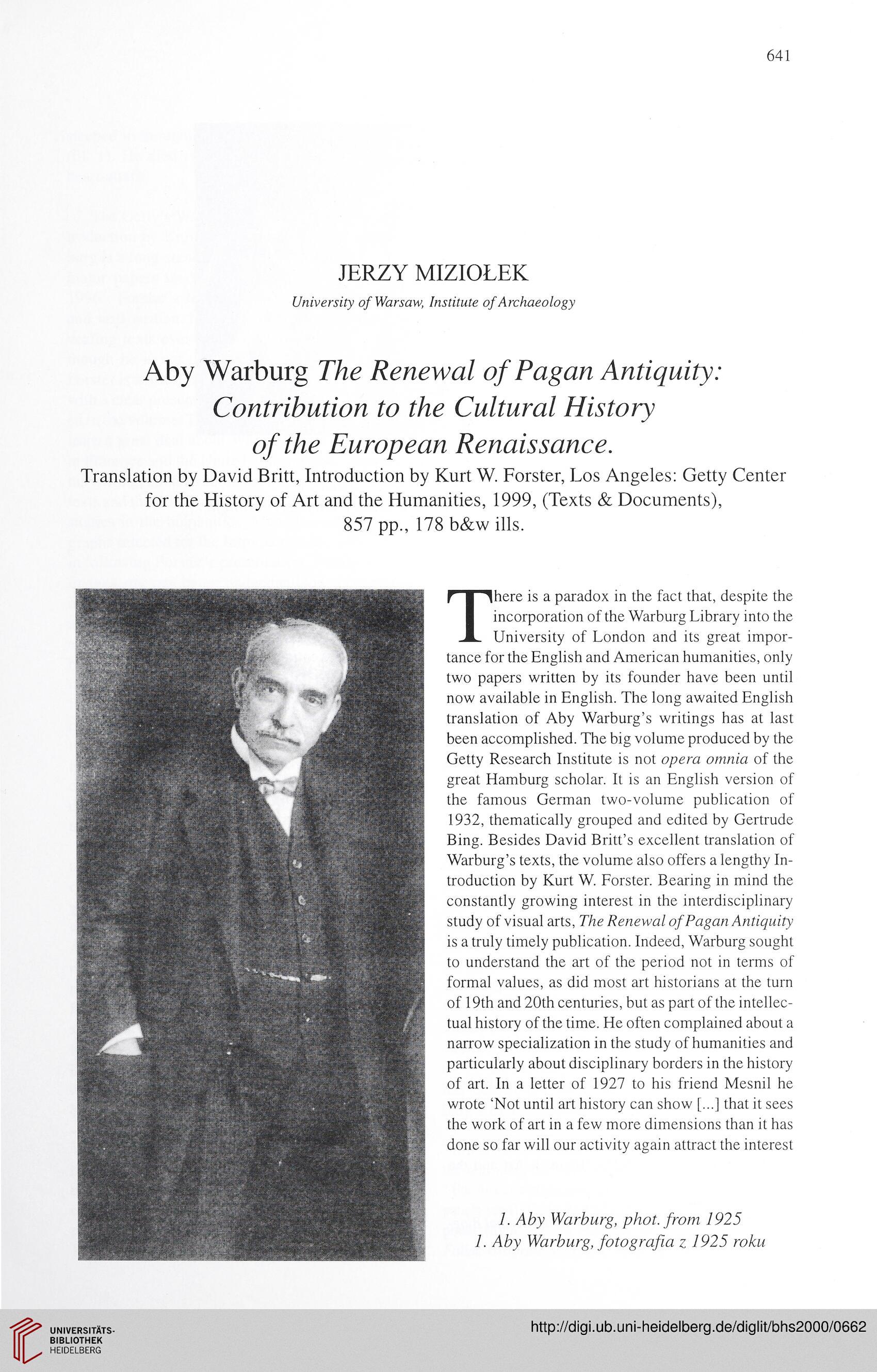641
JERZY MIZIOŁEK
University ofWarsaw, Institute of Archaeology
Aby Warburg The Renewal ofPagan Antiąuity:
Contribution to the Cultural History
ofthe European Renaissance.
Translation by David Britt, Introduction by Kurt W. Forster, Los Angeles: Getty Center
for the History of Art and the Humanities, 1999, (Texts & Documents),
857 pp„ 178 b&w ills.
There is a paradox in the fact that, despite the
incorporation of the Warburg Library into the
University of London and its great impor-
tance for the English and American humanities, only
two papers written by its founder have been until
now available in English. The long awaited English
translation of Aby Warburg’s writings has at last
been accomplished. The big volume produced by the
Getty Research Institute is not opera omnia of the
great Hamburg scholar. It is an English version of
the famous German two-volume publication of
1932, thematically grouped and edited by Gertrudę
Bing. Besides David Britfs excellent translation of
Warburg’s texts, the volume also offers a lengthy In-
troduction by Kurt W. Forster. Bearing in mind the
constantly growing interest in the interdisciplinary
study of visual arts, The Renewal ofPagan Antiquity
is a truły timely publication. Indeed, Warburg sought
to understand the art of the period not in terms of
formal values, as did most art historians at the turn
of 19th and 20th centuries, but as part of the intellec-
tual history ofthe time. He often complained about a
narrow specialization in the study of humanities and
particularly about disciplinary borders in the history
of art. In a letter of 1927 to his friend Mesnil he
wrote ‘Not until art history can show [...] that it sees
the work of art in a few morę dimensions than it has
done so far will our activity again attract the interest
1. Aby Warburg, phot. from 1925
1. Aby Warburg, fotografia z 1925 roku
JERZY MIZIOŁEK
University ofWarsaw, Institute of Archaeology
Aby Warburg The Renewal ofPagan Antiąuity:
Contribution to the Cultural History
ofthe European Renaissance.
Translation by David Britt, Introduction by Kurt W. Forster, Los Angeles: Getty Center
for the History of Art and the Humanities, 1999, (Texts & Documents),
857 pp„ 178 b&w ills.
There is a paradox in the fact that, despite the
incorporation of the Warburg Library into the
University of London and its great impor-
tance for the English and American humanities, only
two papers written by its founder have been until
now available in English. The long awaited English
translation of Aby Warburg’s writings has at last
been accomplished. The big volume produced by the
Getty Research Institute is not opera omnia of the
great Hamburg scholar. It is an English version of
the famous German two-volume publication of
1932, thematically grouped and edited by Gertrudę
Bing. Besides David Britfs excellent translation of
Warburg’s texts, the volume also offers a lengthy In-
troduction by Kurt W. Forster. Bearing in mind the
constantly growing interest in the interdisciplinary
study of visual arts, The Renewal ofPagan Antiquity
is a truły timely publication. Indeed, Warburg sought
to understand the art of the period not in terms of
formal values, as did most art historians at the turn
of 19th and 20th centuries, but as part of the intellec-
tual history ofthe time. He often complained about a
narrow specialization in the study of humanities and
particularly about disciplinary borders in the history
of art. In a letter of 1927 to his friend Mesnil he
wrote ‘Not until art history can show [...] that it sees
the work of art in a few morę dimensions than it has
done so far will our activity again attract the interest
1. Aby Warburg, phot. from 1925
1. Aby Warburg, fotografia z 1925 roku




